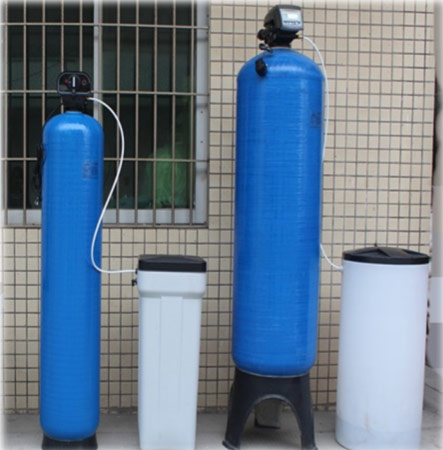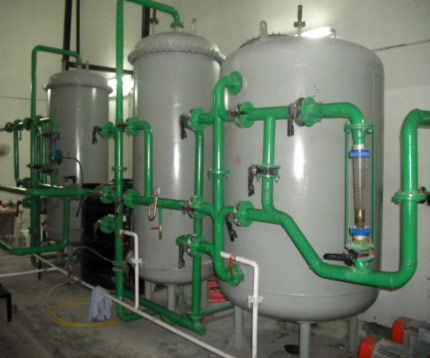Products
SOFTNER
Water Softeners have wide application in various areas ranging from industrial to domestic purpose. The main role of softener is to remove hardness from water by the help of cation based resin. Hard water is caused by “hardness ions”. Typically these hardness ions are Calcium, Ca++, and Magnesium, Mg+. Hardness in water causes scale build up in pipes and equipment. Hardness will reduce the efficiency of any boiler or heat exchanger. Cooling towers, washers, fixtures, sinks and other surfaces in contact with hard water will require more frequent maintenance, and will have a much shorter useful life. In the ion exchange water softening process, water is passed through a bed of sulfonated styrene-divynalbenzene spherical resin beads (about 1 mm in diameter). The exchange sites created on the beads by the sulfonation process are then saturated with sodium ions by passing a brine solution through the resin. The ion exchange “softening” process takes place when the hardness ions, Ca++ and Mg++ attach themselves to the resin beads causing the sodium ions on the resin beads to be released into the water. When the resin becomes saturated with calcium and magnesium, it is regenerated by passing an NaCl brine solution through the resin. The high concentration of sodium ions in the brine causes the reaction to be reversed with sodium replacing the calcium and magnesium ions which are then discharged into the waste water softeners. In a Down flow Softener, water enters from top of the vessel & soft water is received from bottom.
Types of Softener:
- Automatic Softener (FRP)
- Semiautomatic Softener (FRP)
- Manual Up flow Softener (Mild Steel)
- Manual Down flow Softener (Mild Steel)
*SS304 & SS316 Filters is also available.
FRP WATER SOFTENER
 |
Water Softeners generally consist of a FRP pressure vessel, an injector assembly & a plastic brine tank. The pressure vessel contains a strong cation exchange resin which eliminates hardness from water through ion-exchange principle. These resins when get exhausted, brine solution from the brine tank is used to recharge it by exchanging ions (Ca ion is exchanged with Na ion) thereby making the resin functional again.
FEATURES
|
Available in all capacities between 500 LPH to 20,000 LPH.
UNICHEM MILD STEEL DOWNFLOW SOFTENER

Introduction
Water Softeners have wide application in various areas ranging from industrial to domestic purpose. The main role of softener is to remove hardness from water by the help of cation based resin. Hard water is caused by “hardness ions”. Typically these hardness ions are Calcium, Ca++, and Magnesium, Mg+. Hardness in water causes scale build up in pipes and equipment. Hardness will reduce the efficiency of any boiler or heat exchanger. Cooling towers, washers, fixtures, sinks and other surfaces in contact with hard water will require more frequent maintenance, and will have a much shorter useful life. In the ion exchange water softening process, water is passed through a bed of sulfonated styrene-divynalbenzene spherical resin beads (about 1 mm in diameter). The exchange sites created on the beads by the sulfonation process are then saturated with sodium ions by passing a brine solution through the resin. The ion exchange “softening” process takes place when the hardness ions, Ca++ and Mg++ attach themselves to the resin beads causing the sodium ions on the resin beads to be released into the water. When the resin becomes saturated with calcium and magnesium, it is regenerated by passing an NaCl brine solution through the resin. The high concentration of sodium ions in the brine causes the reaction to be reversed with sodium replacing the calcium and magnesium ions which are then discharged into the waste water softeners. In a Down flow Softener, water enters from top of the vessel & soft water is received from bottom.
The Ion Exchange Softening Process
In the ion exchange water softening process, water is passed through a bed of sulfonated styrene-divynalbenzene spherical resin beads (about 1 mm in diameter).
The exchange sites created on the beads by the sulfonation process are then saturated with sodium ions by passing a brine solution through the resin. The ion exchange “softening” process takes place when the hardness ions, Ca++ and Mg++ attach themselves to the resin beads causing the sodium ions on the resin beads to be released into the water.
Using an Ion Exchange Column (R = Ion Exchange Resin Site)
Ca++ (aq) + Na2R (solid) CaR(solid) + 2Na+ (aq)
When the resin becomes saturated with calcium and magnesium, it is regenerated by passing a NaCl brine solution through the resin. The high concentration of sodium ions in the brine causes the reaction to be reversed with sodium replacing the calcium and magnesium ions which are then discharged into the waste water.
2Na+ + (aq.con.) + CaR (solid) Na2R (solid) + Ca++ (aq)
All true water softeners work on this principal.
S.No |
Dia |
HOS |
Flow (Max.) |
Flow(Min.) |
1. |
0.6 |
2 |
11.3 |
2.1 |
2. |
0.8 |
2 |
20.1 |
3.8 |
3. |
0.8 |
2.5 |
20.1 |
3.8 |
4. |
1 |
2 |
31.4 |
5.9 |
5. |
1 |
2.5 |
31.4 |
5.9 |
6. |
1.2 |
2 |
45.2 |
8.5 |
7. |
1.2 |
2.5 |
45.2 |
8.5 |
8. |
1.4 |
2 |
61.5 |
11.5 |
9. |
1.4 |
2.5 |
61.5 |
11.5 |
10. |
1.6 |
2 |
80.4 |
15.1 |
11. |
1.6 |
2.5 |
80.4 |
15.1 |
12. |
1.8 |
2 |
101.7 |
19.1 |
13. |
1.8 |
2.5 |
101.7 |
19.1 |
14. |
2 |
2 |
125.6 |
23.6 |
15. |
2 |
2.5 |
125.6 |
23.6 |
16. |
2.2 |
2 |
152 |
28.5 |
17. |
2.2 |
2.5 |
152 |
28.5 |
18. |
2.4 |
2 |
180.9 |
33.9 |
19. |
2.4 |
2.5 |
180.9 |
33.9 |
20. |
2.6 |
2 |
212.3 |
39.8 |
21. |
2.6 |
2.5 |
212.3 |
39.8 |
22. |
2.8 |
2 |
246.2 |
46.2 |
23. |
2.8 |
2.5 |
246.2 |
46.2 |
|
3 |
2 |
282.6 |
53 |
|
3 |
2.5 |
282.6 |
53 |